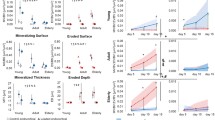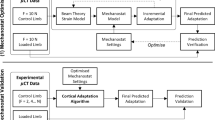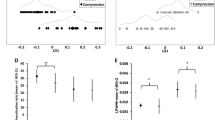Abstract
Bone has an adaptive capacity to maintain structural integrity. However, there seems to be a heterogeneous cortical (re)modeling response to loading at different regions within the same bone, which may lead to inconsistent findings since most studies analyze only one region. It remains unclear if the local mechanical environment is responsible for this heterogeneous response and whether both formation and resorption are affected. Thus, we compared the formation and resorptive response to in vivo loading and the strain environment at two commonly analyzed regions in the mouse tibia, the mid-diaphysis and proximal metaphysis. We quantified cortical surface (re)modeling by tracking changes between geometrically aligned consecutive in vivo micro-tomography images (time lapse 15 days). We investigated the local mechanical strain environment using finite element analyses. The relationship between mechanical stimuli and surface (re)modeling was examined by sub-dividing the mid-diaphysis and proximal metaphysis into 32 sub-regions. In response to loading, metaphyseal cortical bone (re)modeled predominantly at the periosteal surface, whereas diaphyseal (re)modeling was more pronounced at the endocortical surface. Furthermore, different set points and slopes of the relationship between engendered strains and remodeling response were found for the endosteal and periosteal surfaces at the metaphyseal and diaphyseal regions. Resorption was correlated with strain at the endocortical, but not the periosteal surfaces, whereas, formation correlated with strain at all surfaces, except at the metaphyseal periosteal surface. Therefore, besides mechanical stimuli, other non-mechanical factors are likely driving regional differences in adaptation. Studies investigating adaptation to loading or other treatments should consider region-specific (re)modeling differences.







Similar content being viewed by others
References
Plochocki JH, Rivera JP, Zhang C et al (2008) Bone modeling response to voluntary exercise in the hindlimb of mice. J Morphol 269(3):313–318. doi:10.1002/jmor.10587
Judex S, Garman R, Squire M et al (2004) Genetically linked site-specificity of disuse osteoporosis. JBMR 19(4):607–613. doi:10.1359/JBMR.040110
Hsieh YF, Robling AG, Ambrosius WT et al (2001) Mechanical loading of diaphyseal bone in vivo: the strain threshold for an osteogenic response varies with location. JBMR 16(12):2291–2297
Birkhold AI, Razi H, Duda GN et al (2016) The periosteal bone surface is less mechano-responsive than the endocortical. Sci Rep 6:23480. doi:10.1038/srep23480
Rubin C, Turner AS, Mallinckrodt C et al (2002) Mechanical strain, induced noninvasively in the high-frequency domain, is anabolic to cancellous bone, but not cortical bone. Bone 30(3):445–452
Willie BM, Birkhold AI, Razi H et al (2013) Diminished response to in vivo mechanical loading in trabecular and not cortical bone in adulthood of female C57Bl/6 mice coincides with a reduction in deformation to load. Bone 55(2):335–346. doi:10.1016/j.bone.2013.04.023
Lieberman DE, Pearson OM, Polk JD et al (2003) Optimization of bone growth and remodeling in response to loading in tapered mammalian limbs. J Exp Biol 206(18):3125. doi:10.1242/jeb.00514
Hamrick MW, Skedros JG, Pennington C et al (2006) Increased osteogenic response to exercise in metaphyseal versus diaphyseal cortical bone. J Musculoskelet Neuronal Interact 6(3):258–263
Fritton JC, Myers ER, Wright TM et al (2005) Loading induces site-specific increases in mineral content assessed by microcomputed tomography of the mouse tibia. Bone 36(6):1030–1038. doi:10.1016/j.bone.2005.02.013
Sugiyama T, Price JS, Lanyon LE (2010) Functional adaptation to mechanical loading in both cortical and cancellous bone is controlled locally and is confined to the loaded bones. Bone 46(2):314–321. doi:10.1016/j.bone.2009.08.054
Bertram JE, Biewener AA (1988) Bone curvature: sacrificing strength for load predictability. J Theor Biol 131(1):75–92
Frost HM (1990) Skeletal structural adaptations to mechanical usage (SATMU): 1. Redefining Wolff’s law: the bone modeling problem. Anat Rec 226(4):403–413. doi:10.1002/ar.1092260402
Frost HM (1990) Skeletal structural adaptations to mechanical usage (SATMU): 2. Redefining Wolff’s law: the remodeling problem. Anat Rec 226(4):414–422. doi:10.1002/ar.1092260403
Hillam RA, Goodship AE, Skerry TM (2015) Peak strain magnitudes and rates in the tibia exceed greatly those in the skull: an in vivo study in a human subject. J Biomech 48(12):3292–3298. doi:10.1016/j.jbiomech.2015.06.021
Lieberman DE (1996) How and why humans grow thin skulls: experimental evidence for systemic cortical robusticity. Am J Phys Anthropol 101(2):217–236
Alexandre C, Vico L (1996) Adaptation of the skeleton to microgravity. Nouvelle Revue Aeronautique Astronautique 4:34–37
Leblanc AD, Schneider VS, Evans HJ et al (1990) Bone mineral loss and recovery after 17 weeks of bed rest. J Bone Miner Res 5(8):843–850. doi:10.1002/jbmr.5650050807
Currey JD (2002) Bones: structure and mechanics: chapter 11: modeling and reconstruction. Princeton University Press, Princeton
Rubin CT, Lanyon LE (1985) Regulation of bone mass by mechanical strain magnitude. Calcif Tissue Int 37(4):411–417
Mosley JR, March BM, Lynch J et al (1997) Strain magnitude related changes in whole bone architecture in growing rats. Bone 20(3):191–198
Turner CH, Forwood MR, Rho JY et al (1994) Mechanical loading thresholds for lamellar and woven bone formation. J Bone Miner Res 9(1):87–97. doi:10.1002/jbmr.5650090113
Carter DR (1982) The relationship between in vivo strains and cortical bone remodeling. Crit Rev Biomed Eng 8(1):1–28
Skerry TM (2006) One mechanostat or many? Modifications of the site-specific response of bone to mechanical loading by nature and nurture. J Musculoskelet Neuronal Interact 6(2):122–127
Gross TS, Edwards JL, McLeod KJ et al (1997) Strain gradients correlate with sites of periosteal bone formation. J Bone Miner Res 12(6):982–988. doi:10.1359/jbmr.1997.12.6.982
Judex S, Gross TS, Zernicke RF (1997) Strain gradients correlate with sites of exercise-induced bone-forming surfaces in the adult skeleton. J Bone Miner Res 12(10):1737–1745
Razi H, Birkhold AI, Weinkamer R et al (2015) Aging leads to a dysregulation in mechanically driven bone formation and resorption. JBMR 30(10):1864–1873. doi:10.1002/jbmr.2528
O’Connor JA, Lanyon LE, MacFie H (1982) The influence of strain rate on adaptive bone remodelling. J Biomech 15(10):767–781
Brown TD, Pedersen GM et al (1990) Toward an identification of mechanical parameters initiating periosteal remodeling—a combined experimental and analytical approach. J Biomech 23(9):893–905
Wallace IJ, Tommasini SM, Judex S et al (2012) Genetic variations and physical activity as determinants of limb bone morphology: an experimental approach using a mouse model. Am J Phys Anthropol 148(1):24–35. doi:10.1002/ajpa.22028
Farber CR, Kelly SA, Baruch E et al (2011) Identification of quantitative trait loci influencing skeletal architecture in mice: emergence of Cdh11 as a primary candidate gene regulating femoral morphology. JBMR 26(9):2174–2183. doi:10.1002/jbmr.436
Carter Y, Thomas CDL, Clement JG et al (2013) Variation in osteocyte lacunar morphology and density in the human femur—a synchrotron radiation micro-CT study. Bone 52(1):126–132. doi:10.1016/j.bone.2012.09.010
Britz HM, Carter Y, Jokihaara J et al (2012) Prolonged unloading in growing rats reduces cortical osteocyte lacunar density and volume in the distal tibia. Bone 51(5):913–919. doi:10.1016/j.bone.2012.08.112
Hernandez CJ, Majeska RJ, Schaffler MB (2004) Osteocyte density in woven bone. Bone 35(5):1095–1099. doi:10.1016/j.bone.2004.07.002
Britz HM, Jokihaara J, Leppänen OV et al (2012) The effects of immobilization on vascular canal orientation in rat cortical bone. J Anat 220(1):67–76. doi:10.1111/j.1469-7580.2011.01450.x
Cummings SR, Karpf DB, Harris F et al (2002) Improvement in spine bone density and reduction in risk of vertebral fractures during treatment with antiresorptive drugs. Am J Med 112(4):281–289
Riggs BL, Melton LJ III (2002) Bone turnover matters: the raloxifene treatment paradox of dramatic decreases in vertebral fractures without commensurate increases in bone density. JBMR 17(1):11–14. doi:10.1359/jbmr.2002.17.1.11
Faulkner KG (2000) Bone matters: are density increases necessary to reduce fracture risk? JBMR 15(2):183–187
Popp KL, McDermott W, Hughes JM et al (2016) Bone strength estimates relative to vertical ground reaction force discriminates women runners with stress fracture history. Bone 94:22–28. doi:10.1016/j.bone.2016.10.006
Buettmann EG, Silva MJ (2016) Development of an in vivo bone fatigue damage model using axial compression of the rabbit forelimb. J Biomech 49(14):3564–3569. doi:10.1016/j.jbiomech.2016.08.020
Birkhold AI, Razi H, Duda GN et al (2014) The influence of age on adaptive bone formation and bone resorption. Biomaterials 35(34):9290–9301. doi:10.1016/j.biomaterials.2014.07.051
Birkhold AI, Razi H, Duda GN et al (2014) Mineralizing surface is the main target of mechanical stimulation independent of age: 3D dynamic in vivo morphometry. Bone 66:15–25. doi:10.1016/j.bone.2014.05.013
Birkhold AI, Razi H, Weinkamer R et al (2015) Monitoring in vivo (re)modeling: a computational approach using 4D micro CT data to quantify bone surface movements. Bone 75:210–221. doi:10.1016/j.bone.2015.02.027
Razi H, Birkhold AI, Zaslansky P et al (2015) Skeletal maturity leads to a reduction in the strain magnitudes induced within the bone: a murine tibia study. Acta Biomater 13:301–310. doi:10.1016/j.actbio.2014.11.021
Dempster DW, Compston JE, Drezner MK et al (2013) Standardized nomenclature, symbols, and units for bone histomorphometry: a 2012 update of the report of the ASBMR Histomorphometry Nomenclature Committee. J Bone Mine Res 28(1):2–17. doi:10.1002/jbmr.1805
Jilka RL (2013) The relevance of mouse models for investigating age-related bone loss in humans. J Gerontol Ser A Biol Sci Med Sci 68(10):1209–1217. doi:10.1093/gerona/glt046
Pødenphant J, Engel U (1987) Regional variations in histomorphometric bone dynamics from the skeleton of an osteoporotic woman. Calcif Tissue Int 40(4):184–188
Fan W, Crawford R, Xiao Y (2008) Structural and cellular differences between metaphyseal and diaphyseal periosteum in different aged rats. Bone 42(1):81–89. doi:10.1016/j.bone.2007.08.048
Villemure I, Stokes IAF (2009) Growth plate mechanics and mechanobiology. A survey of present understanding. J Biomech 42(12):1793–1803. doi:10.1016/j.jbiomech.2009.05.021
Cadet ER, Gafni RI, McCarthy EF et al (2003) Mechanisms responsible for longitudinal growth of the cortex: coalescence of trabecular bone into cortical bone. J Bone Joint Joint Surg 85A(9):1739–1748
Rosner B (1995) Fundamentals of biostatistics. Duxbury Press, Pacific Grove, p 507
Meganck JA, Kozloff KM, Thornton MM et al (2009) Beam hardening artifacts in micro-computed tomography scanning can be reduced by X-ray beam filtration and the resulting images can be used to accurately measure BMD. Bone 45(6):1104–1116. doi:10.1016/j.bone.2009.07.078
Holguin N, Brodt MD, Sanchez ME et al (2013) Adaptation of tibial structure and strength to axial compression depends on loading history in both C57BL/6 and BALB/c mice. Calcif Tissue Int 93(3):211–221. doi:10.1007/s00223-013-9744-4
Lynch ME, Main RP, Xu Q et al (2011) Tibial compression is anabolic in the adult mouse skeleton despite reduced responsiveness with aging. Bone 49(3):439–446. doi:10.1016/j.bone.2011.05.017
Acknowledgements
The authors would like to thank Marta Aido and Tobias Thiele for helping with the animal experiments and Mario Thiele for assistance with the µCT imaging. We thank Steffen Prohaska and Hans-Christian Hege from Zuse Institute for use of ZibAMIRA software. This study was partially supported by the German Research Foundation (Deutsche Forschungsgemeinschaft; WI 3761/4-1, CH1123/4-1, DU 298/21-1), the German Federal Ministry of Education and Research (Bundesministerium für Bildung und Forschung: TP5/DIMEOs), the Shriners Hospitals for Children, and the Réseau de recherche en santé buccodentaire et osseuse recruitment aid program.
Author information
Authors and Affiliations
Corresponding author
Ethics declarations
Conflict of interest
Annette I. Birkhold, Hajar Razi, Georg N. Duda, Sara Checa, and Bettina M. Willie have no conflicts of interest.
Animal Rights
Animal studies were performed in accordance with an ethical animal use protocol approved by the local legal representative (LAGeSo Berlin, G0333/09).
Rights and permissions
About this article
Cite this article
Birkhold, A.I., Razi, H., Duda, G.N. et al. Tomography-Based Quantification of Regional Differences in Cortical Bone Surface Remodeling and Mechano-Response. Calcif Tissue Int 100, 255–270 (2017). https://doi.org/10.1007/s00223-016-0217-4
Received:
Accepted:
Published:
Issue Date:
DOI: https://doi.org/10.1007/s00223-016-0217-4




